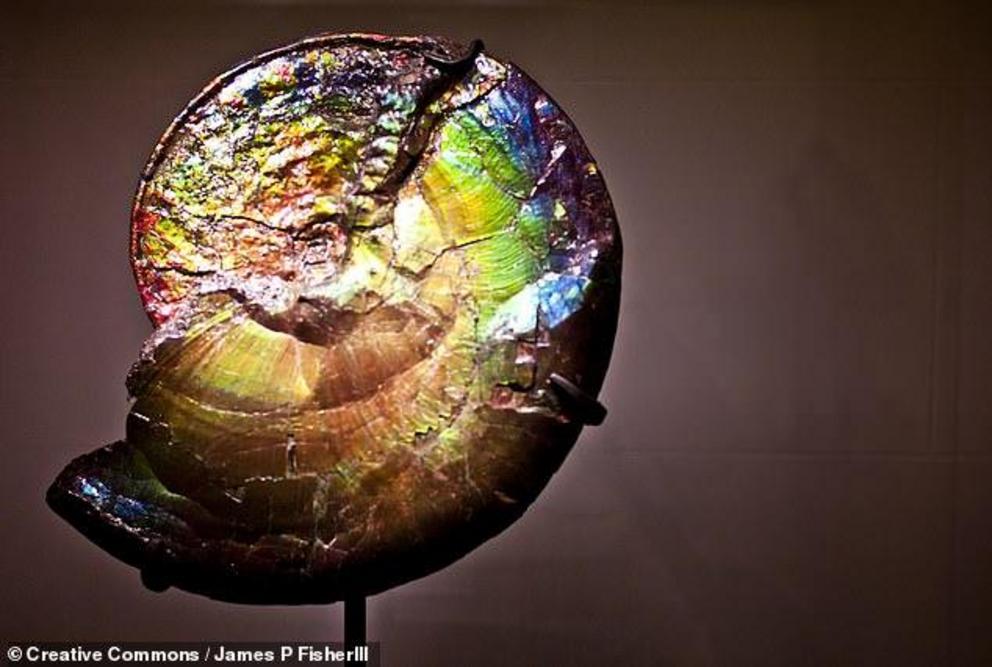Gemstone miners in Canada accidentally stumbled across a fossil of the ancient sea monster Tylosaurus which lived 70 million years ago
- Miners were hunting for a rainbow-coloured, opal-like gemstone for jewellery
- They found a type of mosasaur — a marine reptile from the time of the dinosaurs
- Its fossilised skeleton is almost entirely complete and only missing its flippers
- Mosasaurs were arch predators with fearsome teeth for gobbling up their prey
Hunting for shiny, rainbow-coloured gemstones, miners found a different kind of treasure — a wonderfully preserved fossil skeleton of an ancient sea monster.
The marine reptile lived 70 million years ago — at the same time as the dinosaurs — and was unearthed from a part of Alberta, Canada, that used to be underwater.
The skeleton of the fearsome predator has, rarely, been very well preserved, with only its flippers missing.
Hunting for shiny, rainbow-coloured gemstones, miners found a different kind of treasure — a wonderfully preserved fossil skeleton of an ancient sea monster.

Diggers unearthed the fossil of a mosasaur — specifically a Tylosaurus — a marine reptile that lived around 70 million years ago, during the period in which dinosaurs roamed the Earth. Pictured, the specimen was sealed in a burlap-and-plaster field jacket for transport.
WHAT IS A TYLOSAURUS?
These animals are now extinct but they roamed the oceans at the time of the dinosaurs.
They are often colloquially known as the T-rex of the sea, due to their fearsome size and nature.
Tylosaurus had a bone protrusion on its head which is believed was used for ramming and disabling its prey.
They could grow up to 50 feet (15 metres) in length and their large head made up around one-sixth of the animal's body weight.
The animal was brought to the public's attention in the film Jurassic World where a Tylosaurus appears to leap out of a tank and devours a dangling shark.
The discovery was made by miners from Enchanted Designs, a firm that makes jewellery from a rainbow-coloured organic gemstone, ammolite, that can form from the remains of ammonites — ancient, nautilus-like shelled creatures.
Instead, the diggers unearthed the fossilised skeleton of a mosasaur — specifically a Tylosaurus — a marine reptile that lived around 70 million years ago, during the period in which dinosaurs roamed the Earth.
At this time, Alberta was submerged, lying underneath the so-called Western Interior Seaway that once stretched all the way from the Arctic Sea down to the Gulf of Mexico.
Miners digging in the Bearpaw Shale rocks that were laid down in this ocean typically unearth one–two fossilised marine reptiles each year.
However, it is rare to unearth a skeleton that is nearly complete.
'We've got everything from the head almost to the tip of the tail,' Donald Henderson, a curator at the Royal Tyrrell Museum of Palaeontology in Drumheller, Alberta, told Live Science.
'We don't have much in the way of flippers. They were lost to decay, or maybe they were bitten off.'
Having been entombed in a soft black-shale mudstone, the beast had been quite well preserved and its skeleton is almost completely intact — although the remains were slightly offset from their expected relative positions.
'It was probably quite rotten when it went to the seabed,' Dr Henderson said
'It looks like it maybe ruptured or broke when it hit the seabed, but otherwise it's pretty good.'

Having been entombed in a soft black-shale mudstone, the beast had been quite well preserved and its skeleton is almost completely intact. Pictured, the specimen was sealed in a burlap-and-plaster field jacket for transport.

The beasts were apex predators, with the preserved remains of other mosasaur's stomach contents — and bite marks found on other fossils — both showing that the creatures ate fish, turtles, ammonites and even other mosasaurs.
The animal was around 20–23 feet (6–7 metres) long.
'I think they had to be big to survive in that environment,' said Dr Henderson.
In fact, they were apex predators, with the preserved remains of other mosasaur's stomach contents — and bite marks found on other fossils — both showing that the creatures ate fish, turtles, ammonites and even other mosasaurs.
Their mouths were particularly vicious, with backwards curving teeth to better eat their prey.
'Once they grabbed you with their main teeth and started to work you back, those teeth would keep the food from struggling out,' Dr Henderson said.
'So, the only way you could slide was down the throat.'
It is too early to say if the newly-discovered mosasaur fossil will go on public display.

It is too early to say if the newly-discovered fossil will go on public display, but if it does it may join other mosasaurs on display at the Royal Tyrrell Museum of Paleontology, pictured.

The discovery was made by miners from Enchanted Designs, a firm that makes jewellery from a rainbow-coloured organic gemstone, ammolite, that can form from the remains of ammonites — ancient, nautilus-like shelled creatures. Pictured, an ammonite preserved in ammolite.

